全文HTML
--> --> -->利用氮化物材料制作光通讯波段探测器主要得益于GaN/AlN异质结足够大的导带带阶(~1.75 eV)[10]和极快的电子弛豫速度(~150 fs)[11]. 为了获得与近红外光子能量相近的子带跃迁能级, 该类型器件通常采用短周期超晶格结构作为吸收区域[4], 其吸收效率直接正比于基态能级上被电子填充的量子阱数[12]. 整个有源区量子阱中载流子的浓度分布受器件内建电场影响, 不仅与其掺杂浓度有关, 还与由极化效应引发的极化电场相关[13]. 从器件结构来看, 影响内建电场的因素包括周期数、材料组分、掺杂浓度等, 目前较为全面地分析上述材料参数对器件能带结构和载流子浓度影响的文献报道仍然较少.
在太赫兹波探测方面, 氮化物材料凭借其大的纵向光学声子能量(GaN材料约92 meV)[14], 比传统的砷化物材料更有潜力实现室温工作, 而且能工作在砷化物器件受材料反射特性限制而不能响应的5—12 THz波段范围[15]. 由于太赫兹波段光子能量小, 特别是在考虑材料极化效应后器件的能级结构需要更为精细的设计, 其主要难点是在保证高效吸收的基础上, 还能实现光生载流子有效输运[16]. 为了解决吸收和输运的问题, Sudradjat等[17]提出了利用双台阶结构来消除势阱层和势垒层的极化电场, 其特点是在势阱层和势垒层中分别插入一层组分、厚度特殊设计的调节层, 这也是目前极有潜力实现室温工作的器件方案之一. 但该结构相比于单一的势阱层和势垒层结构更复杂, 针对其材料结构参数影响有源区电场分布和载流子输运的分析尚未见报道.
本文针对工作于近红外波段的GaN/AlN子带跃迁探测器, 从完整的器件模拟出发, 理论分析了周期数、掺杂浓度、材料组分对能带结构和载流子浓度分布的影响规律. 研究结果表明增加吸收区量子阱的周期数和量子阱掺杂浓度, 以及选择合适的接触层材料组分可以使得更多的量子阱被电子填充. 对于太赫兹波段的子带跃迁探测器, 本文以双台阶器件结构为基础, 分析了有源区主要材料参数对极化电场分布及光生载流子隧穿特性的影响. 我们发现有源区极化电场分布受势垒层组分、台阶势垒层和台阶势阱层厚度变化敏感, 而基本不受势阱层和势垒层厚度的影响. 同时, 降低台阶势垒层铝(Al)组分和适当增加其厚度有利于提高光生载流子的隧穿效率.







对于量子阱能级间的子带跃迁过程, 相应的吸收系数可表达如下[20]:




此外, 基于双台阶结构的太赫兹子带跃迁探测器需要考虑光生载流子的隧穿输运过程, 其隧穿系数随载流子能量变化的关系是由基于弹道输运原理的contact-block-reduction (CBR)方法[21]求解获得. 该方法以格林函数(Green’s function)为基础, 可以有效分析任意形状器件以及具有任意端口数的开放量子系统的电子传输特性.
3.1.近红外波段子带跃迁探测器
针对工作于近红外波段的氮化物子带跃迁探测器, 为了获得极化场作用下器件真实的载流子浓度分布, 需要仿真包含有源区和电极接触层的完整材料结构. 该类型器件有源区由周期性GaN/AlN异质结材料构成, 已有的文献在建模时一般采用的吸收量子阱周期数不超过20[4,13], 而实际生长的器件结构为了获得足够强的吸收周期数至少为30—50. 因此, 我们以典型的光伏型GaN/AlN子带跃迁探测器为基础[22], 首先研究了吸收量子阱周期数对器件能带结构及载流子浓度分布的影响, 仿真结果如图1所示. 图中从左至右分别表示了量子阱数为10, 20, 50的情况, 下方区域为电子浓度分布, 上方为导带结构, 左下侧的插图为器件材料结构示意图. 图1所示的器件结构中, 底部接触层和顶部接触层均采用未掺杂的AlN材料, 吸收量子阱采用厚度为1.5 nm/1.5 nm的重复性GaN/AlN异质结材料单元, 势阱中n型掺杂浓度1 × 1019 cm–3. 吸收区量子势阱层和势垒层厚度均选取为1.5 nm, 是为了确保参与跃迁的基态能级与激发态能级的能量差刚好接近于1.55 μm的光通讯波长. 这类器件光响应信号的输出主要依赖于吸收光子后引起非对称量子阱结构中电势的变化, 从而改变整体外电路的电势差[23].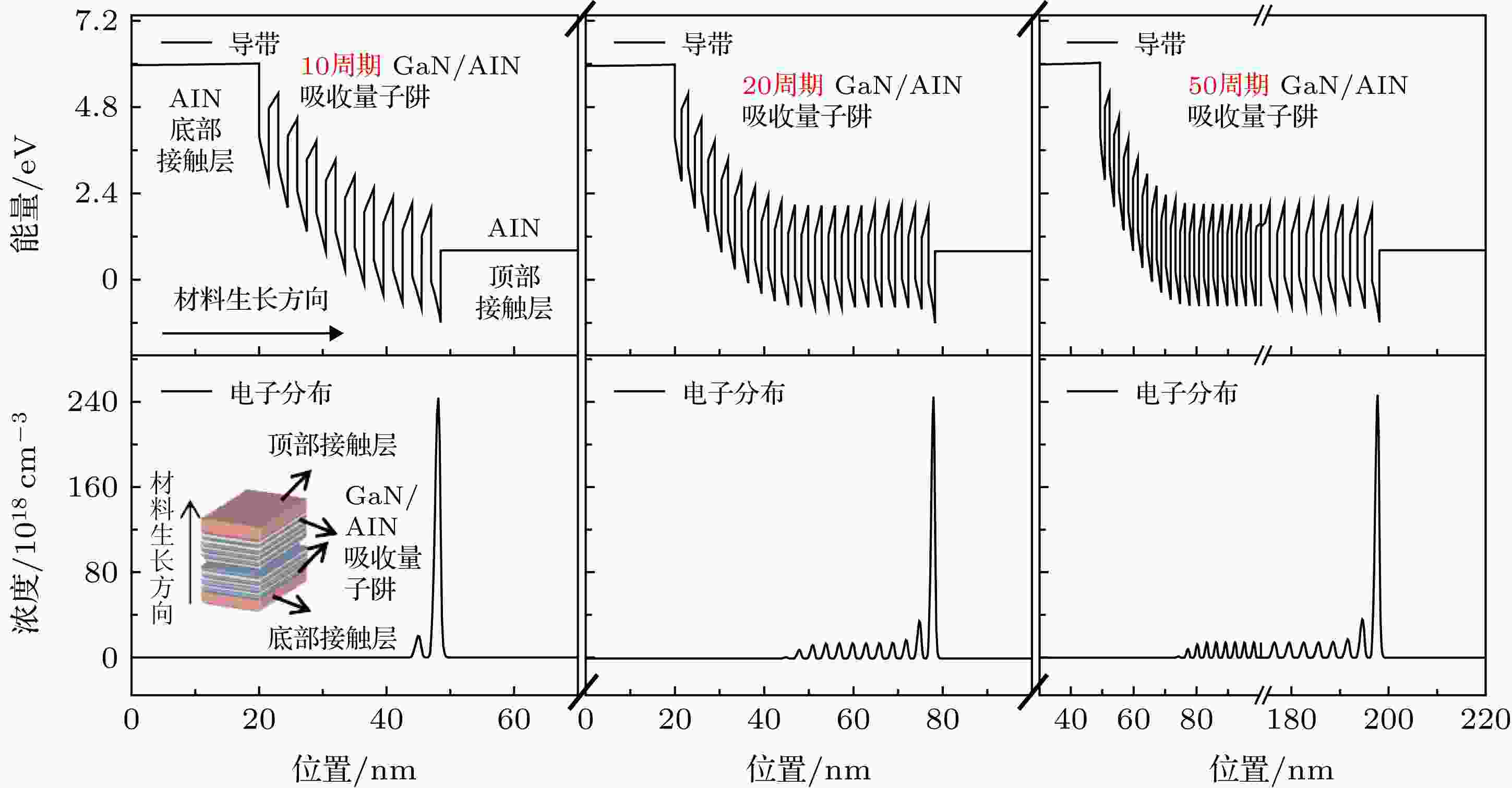 图 1 典型光伏型GaN/AlN子带跃迁探测器量子阱周期数分别为10, 20, 50情况下的导带结构和电子浓度分布, 左下侧的插图为器件材料结构示意图
图 1 典型光伏型GaN/AlN子带跃迁探测器量子阱周期数分别为10, 20, 50情况下的导带结构和电子浓度分布, 左下侧的插图为器件材料结构示意图Figure1. Conduction band profile and electron distribution for typical photovoltaic nitride intersubband photodetectors, with ten periods, twenty periods and fifty periods of GaN/AlN quantum wells, respectively. The inset shows the schematic image of the sample structure.
器件理想的能带结构是吸收量子阱处于平带状态, 且基态能级上有足够的电子填充. 从图1中可以看到, 在该特定掺杂水平的情况下, 三种吸收量子阱周期数不同的器件均有部分势阱区域能带表现为倾斜, 倾斜量子阱中的电子由于受到极化电场的影响而被耗尽. 不难发现被耗尽的量子阱数几乎没有随着吸收阱周期数的增加而增加, 这也意味着随着周期数的增多, 更多的量子势阱处于平带状态, 即有更多的势阱基态能级可被电子有效填充. 紧挨顶部接触层的量子阱出现了极高的载流子浓度分布, 主要是在特定异质结界面形成了二维电子气. 假设施加在有源区吸收量子阱上的内建电场由底部接触层、顶部接触层材料的结构参数以及吸收量子阱的掺杂浓度共同决定, 在上述参数不变的情况下, 改变周期数实际上对总的电场强度不会有大的影响, 这样就可以解释被耗尽的量子阱数为什么不会随着周期数的增加而改变. 从另一种角度思考, 在周期数很多的情况下, 也可以通过仿真少于实际结构的周期数推断出特定结构参数下固定的、将会被耗尽的量子阱数目.
以图1中50个周期的吸收量子阱器件结构为基础, 对势阱中的掺杂浓度进行调节, 仿真得到的能带结构和电子浓度分布如图2所示. 从左至右分别表示势阱中的掺杂浓度依次为5 × 1018 cm–3, 2 × 1019 cm–3和5 × 1019 cm–3. 可以看到, 随着势阱中掺杂浓度的降低, 靠近底部接触层AlN材料方向有更多的吸收量子阱在整个内建电场的作用下发生了倾斜, 即有更多的势阱基态能级能量高于费米能级(0 eV), 从电子浓度分布看则有更多的势阱中的电子被耗尽. 观察处于平带结构的量子阱中电子浓度的具体数值, 可以发现仿真获得的电子浓度略高于掺杂的杂质浓度(设置杂质全部电离), 这主要是由于产生了额外的极化电荷所致. 仿真结果说明势阱中的掺杂浓度会对有源区吸收阱中的内建电场产生影响, 理论上掺杂浓度越高, 在极化电场不变的情况下内建电场受到的抑制作用越强, 从而减少了被耗尽的量子阱数. 但实际在器件工作时, 还需要综合考虑掺杂浓度变高对器件暗电流增加以及引发的多体效应对能带重整的影响[24].
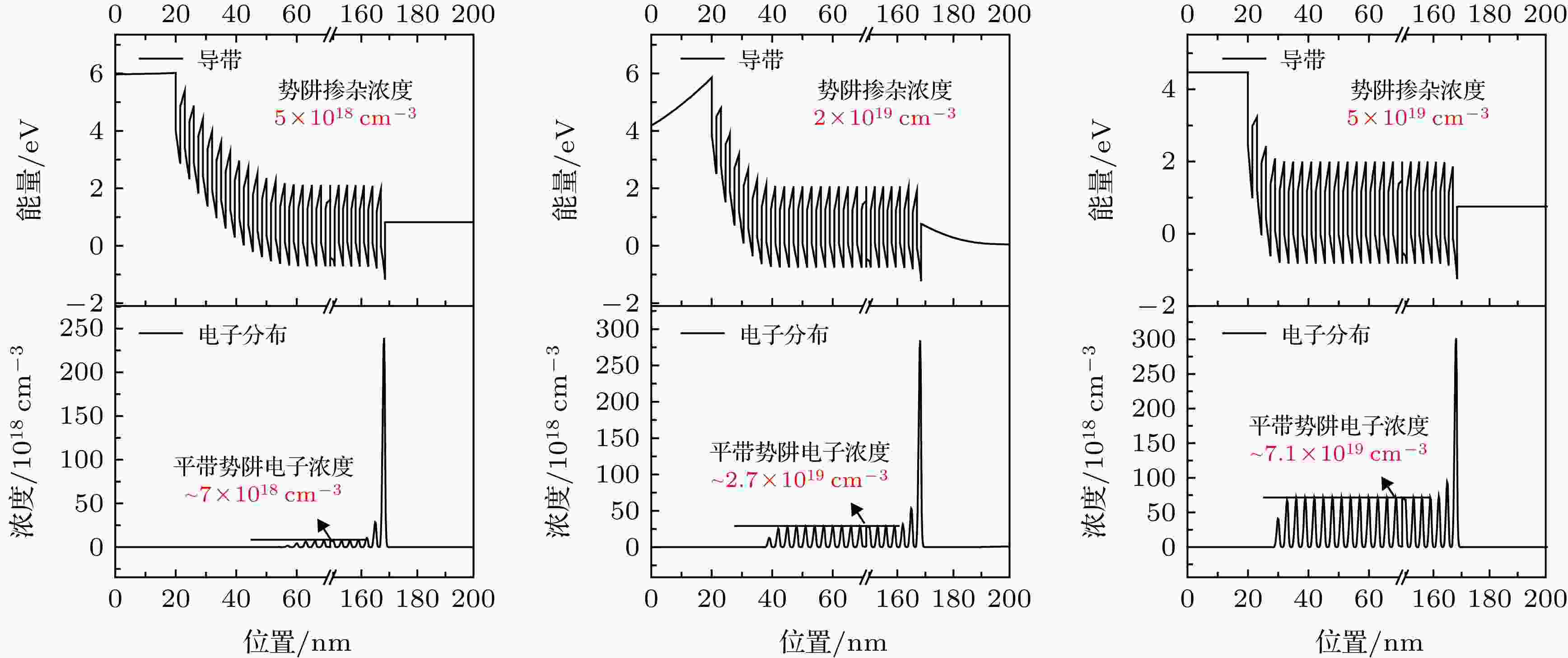 图 2 典型光伏型GaN/AlN子带跃迁探测器量子势阱掺杂浓度分别为5 × 1018 cm–3, 2 × 1019 cm–3和5 × 1019 cm–3情况下的导带结构和电子浓度分布
图 2 典型光伏型GaN/AlN子带跃迁探测器量子势阱掺杂浓度分别为5 × 1018 cm–3, 2 × 1019 cm–3和5 × 1019 cm–3情况下的导带结构和电子浓度分布Figure2. Conduction band profile and electron distribution for typical photovoltaic nitride intersubband photodetectors doped to 5 × 1018 cm–3, 2 × 1019 cm–3 and 5 × 1019 cm–3 in quantum wells, respectively.
此外, 在图1所示的50个周期吸收阱器件结构的基础上, 通过改变底部接触层和顶部接触层Al(Ga)N材料的Al组分, 仿真获得了不同Al组分情况下器件的能带结构和电子浓度分布, 如图3所示. 其中, 势阱层掺杂浓度设置为1 × 1019 cm–3. 从图中可以看出, 当Al组分从100%降低至50%时(接触层从AlN材料变为Al0.5Ga0.5N材料), 靠近底部接触层本来倾斜的量子阱能带变成了平带状态, 有源区极化电场受到抑制. 当Al组分从50%进一步降低至0时(接触层从Al0.5Ga0.5N材料变为GaN材料), 靠近顶部接触层的部分量子阱能带反而发生了倾斜, 造成该量子阱区域内电子的耗尽. 可见采用GaN材料和AlN材料作为接触层时在有源区内将产生方向相反的极化电场, 导致不同区域势阱中电子的耗尽, 而采用Al0.5Ga0.5N材料可以消除极化电场的影响, 使更多的量子阱被电子填充. 该仿真结果表明, 器件设计时接触层材料的Al组分应选取为与有源区吸收量子阱区域的平均Al组分相同, 此时各区域的(平均)晶格常数保持一致, 能最大程度抑制压电极化效应的影响.
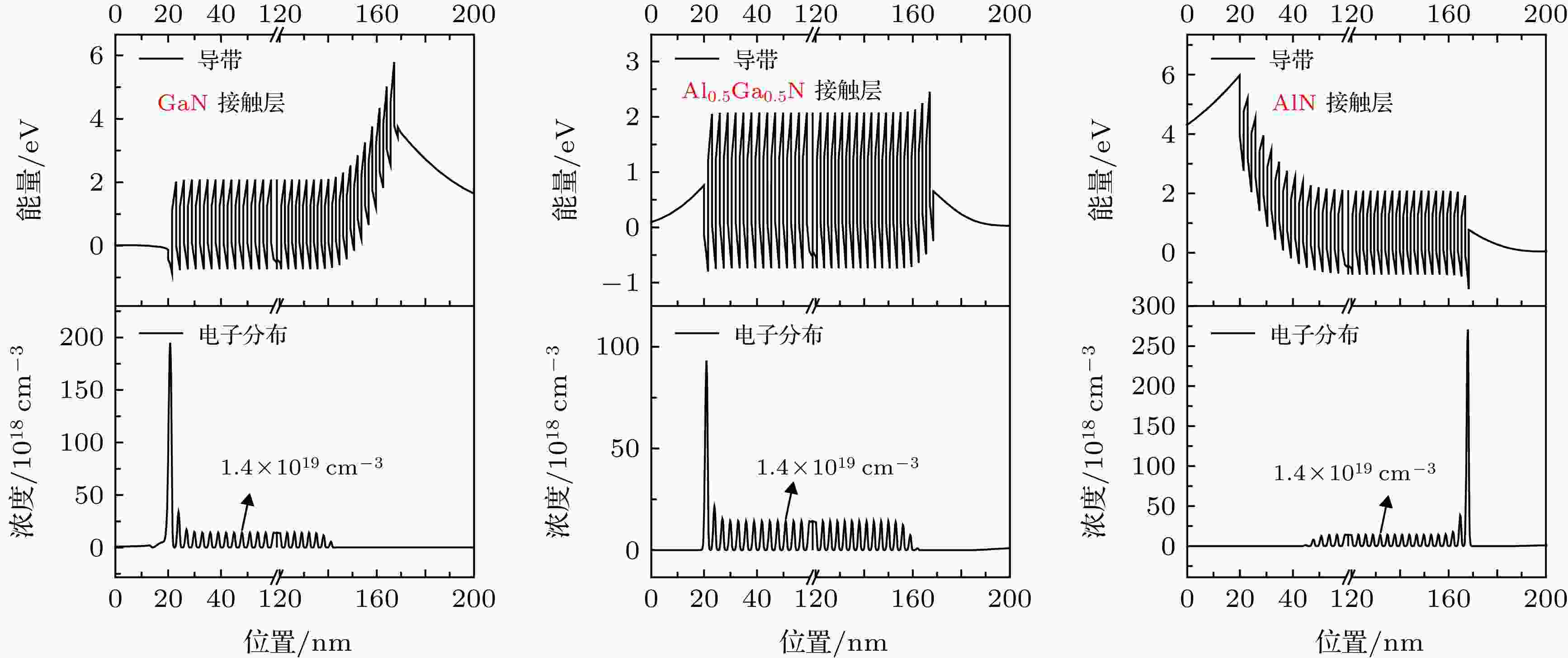 图 3 典型光伏型GaN/AlN子带跃迁探测器分别采用GaN, Al0.5Ga0.5N和AlN材料作为接触层情况下的导带结构和电子浓度分布
图 3 典型光伏型GaN/AlN子带跃迁探测器分别采用GaN, Al0.5Ga0.5N和AlN材料作为接触层情况下的导带结构和电子浓度分布Figure3. Conduction band profile and electron distribution for typical photovoltaic nitride intersubband photodetectors, with GaN, Al0.5Ga0.5N and AlN contact layers, respectively.
2
3.2.太赫兹波段子带跃迁探测器
设计太赫兹波段的氮化物子带跃迁探测器, 通常量子势阱的厚度需要足够大(~10 nm)才能确保基态能级与激发态能级的能量差与太赫兹波的能量相近. 如果采用单一的量子阱结构, 强的极化电场作用将导致跃迁能级均位于三角形势阱底部, 如图4(a)所示. 该情况下, 剧烈倾斜的势阱和势垒能带一方面使得两个跃迁能级的波函数中心在空间位置上不重合导致跃迁效率降低, 另一方面使得光生载流子想要逃离出势阱被外电路收集变得更困难. 双台阶结构子带跃迁探测器是在量子势阱层和势垒层中分别插入一层极化调控层以调节各层材料电场强度的分布, 构建出近似于“方形”的量子势阱, 以解决上述效率降低的问题.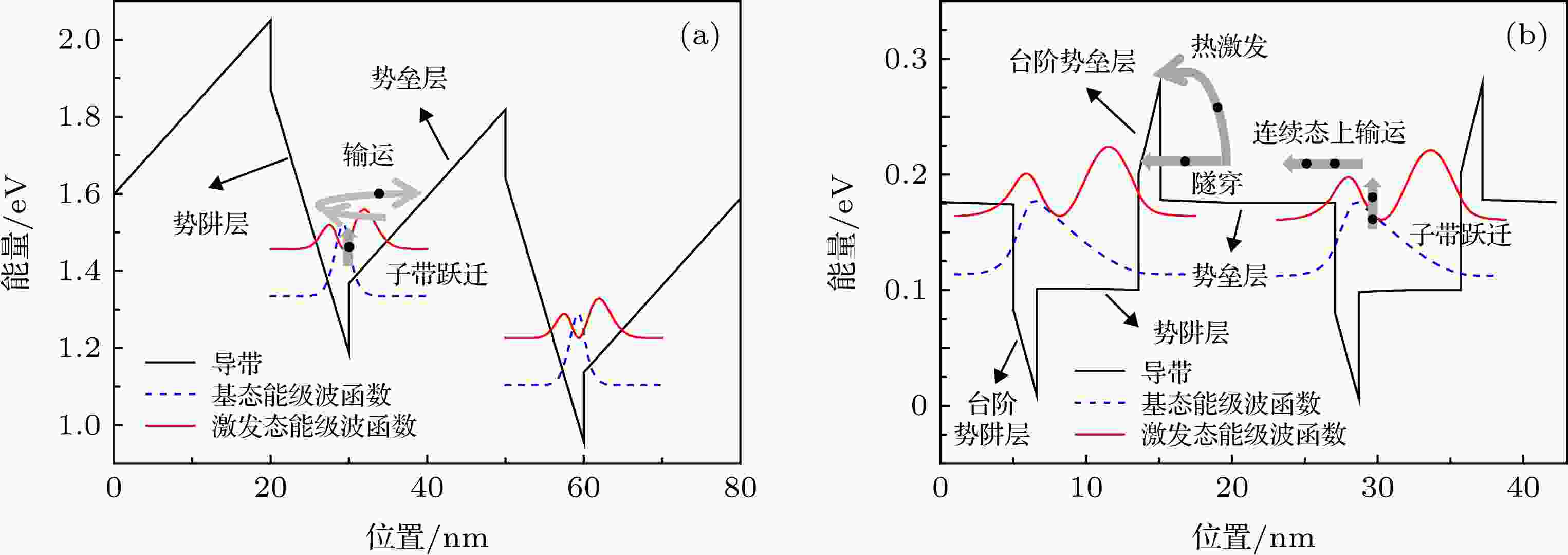 图 4 基于(a)单一量子阱结构和(b)双台阶量子阱结构的太赫兹波段氮化物子带跃迁探测器能带结构和电子波函数分布
图 4 基于(a)单一量子阱结构和(b)双台阶量子阱结构的太赫兹波段氮化物子带跃迁探测器能带结构和电子波函数分布Figure4. Conduction band profile and squared envelope functions for terahertz intersubband photodetectors based on (a) a single barrier and a single well structure and (b) a double-step structure.
图4(b)展示了理想情况下的双台阶结构子带跃迁探测器有源区能带示意图和电子波函数分布, 此时势垒层和势阱层中的极化电场基本被消除, 能带表现为平带状态. 该结构一个基本周期内包含了1.6 nm厚的GaN台阶势阱层、7 nm厚的Al0.08Ga0.92N势阱层、1.5 nm厚的Al0.16Ga0.84N台阶势垒层和12 nm厚的Al0.08Ga0.92N势垒层, 基态能级与激发态能级的能量差约为12 THz. 器件工作时载流子主要经历了子带跃迁、连续态上的输运、隧穿通过或是热激发越过台阶势垒层等几个动力学过程. 要保证光生载流子具有高的输运效率, 一是希望势垒层中的极化电场尽可能小, 二是希望载流子能高效隧穿通过台阶势垒层. 因此, 分析各层材料参数对器件极化电场的影响以及台阶势垒层对光生载流子隧穿的影响对于指导器件设计非常重要.
为了获得准确的极化电场数值(即能带结构分布), 在仿真设计时至少需要覆盖三个周期的吸收阱结构, 以避免边界的人为截断导致极化电场不连续. 虽然以下仿真中没有包含接触层材料, 但后续实际生长器件时只要确保接触层材料的晶格常数与有源区材料的平均晶格常数一致即可忽略由接触层带来的极化效应的影响. 在图4(b)所示材料结构参数的基础上, 首先分析了势垒层电场及势阱层电场随势垒层Al组分(xbr)变化的规律, 分别如图5(a)和图5(b)所示, 正负值分别代表相反的电场方向. 台阶势垒层Al组分(xsbr)始终固定为势阱层Al组分(xw)的2倍是因为在单台阶结构器件中该组分配比下可以获得低的跃迁能量和高的跃迁效率[15].
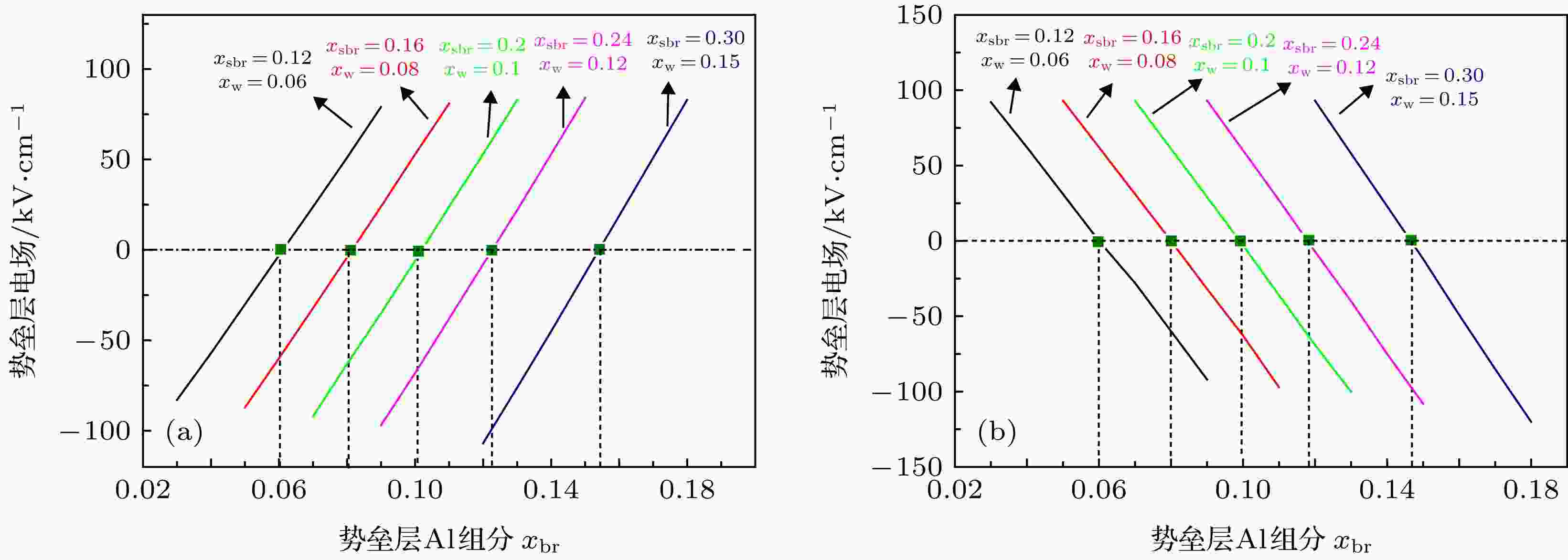 图 5 双台阶结构器件中势垒层电场(a)和势阱层电场(b)随势垒层Al组分变化的关系
图 5 双台阶结构器件中势垒层电场(a)和势阱层电场(b)随势垒层Al组分变化的关系Figure5. (a) Barrier layer polarization fields and (b) well layer polarization fields as a function of Al mole composition of barrier layer (xbr) for double-step devices.
从计算结果来看, 势垒层组分将同时影响势垒层自身和势阱层的电场, 且电场强度值均随势垒层组分变化呈线性关系. 当台阶势垒层Al组分不高于20%时, 势垒层Al组分刚好为其1/2的情况下可以使得势垒层和势阱层中的极化电场基本得到全部消除. 而当台阶势垒层Al组分较大程度地高于20%时, 势垒层Al组分在略偏离其1/2的情况下才能使得势垒层和势阱层的极化电场为零, 且偏离量随台阶势垒中Al组分的增大而增大. 出现该现象可能的原因是台阶势垒层Al组分增加到一定程度后, 压电极化效应成为主要的影响因素, 而决定压电极化效应的晶格失配量随Al组分变化并不是严格的线性关系. 该仿真结果说明在上述特定材料厚度下, 应尽量控制台阶势垒层Al组分不超过20%, 同时势阱层和势垒层Al组分约为其1/2时可以基本消除这两层材料中的极化电场, 构建出较为理想的“方形”势阱结构. 因此, 在后续器件设计时, 若各层材料厚度以及台阶势垒层和势阱层组分已确定, 需要通过计算选取优化的势垒层组分同时使得势垒层和势阱层中的极化电场强度尽可能小.
接下来, 仍以图4(b)所示的材料结构为基础, 分析了有源区各层材料厚度对势垒层极化电场的影响规律, 如图6所示. 左侧纵坐标代表势垒层的Al组分, 每一个数据点的选择是为了保证势垒层中的极化电场始终保持为零, 右侧纵坐标表示为势垒层中的极化电场值. 可以看到, 当台阶势垒层厚度和台阶势阱层厚度发生改变时, 势垒层中的极化电场将发生较为剧烈的变化, 需要对势垒层中的Al组分进行调节才能维持其极化电场值为零. 另一方面, 即使势阱层和势垒层的厚度发生改变, 势垒层中的极化电场都不会受到影响, 因此势垒层的Al组分不需要改变就可以保持势垒层中的极化电场始终为零. 实际上, 在台阶势垒层和台阶势阱层中本身就存在强的极化电场(~MV/cm), 当其厚度发生改变时, 将导致整个有源区的电场分布都会受到比较大的影响. 根据以上仿真结果可知, 在材料组分确定的情况下, 势阱层和势垒层的厚度可以任意调节以获得期望的跃迁能级分布, 而在这过程中并不会影响势垒层的电场分布. 然而, 如果台阶势阱层和台阶势垒层的厚度发生了改变, 则需要对材料组分重新设计.
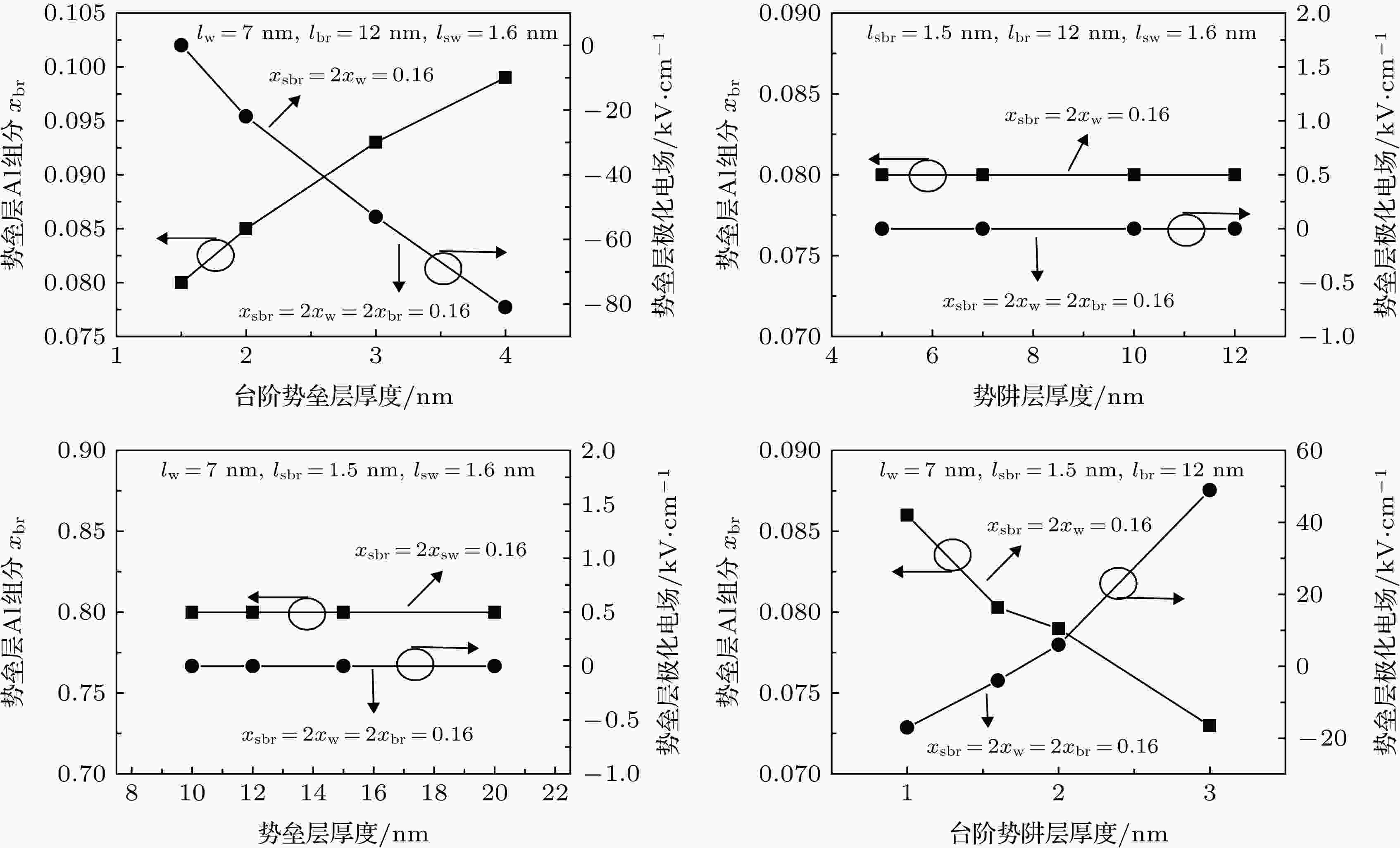 图 6 双台阶结构器件中势垒层极化电场随各层材料厚度变化的关系(右侧纵坐标), 以及为了保持势垒层中极化电场始终为零, 势垒层Al组分随厚度的变化关系(左侧纵坐标)
图 6 双台阶结构器件中势垒层极化电场随各层材料厚度变化的关系(右侧纵坐标), 以及为了保持势垒层中极化电场始终为零, 势垒层Al组分随厚度的变化关系(左侧纵坐标)Figure6. The influence of each layer thickness on the barrier layer polarization fields (right ordinates) and the change of Al mole composition of barrier under the condition that the polarization field in barrier layer is kept at zero (left ordinates) for double-step devices.
根据双台阶结构器件工作原理, 光生载流子的输运不仅受势垒层极化电场的影响, 还受到台阶势垒层所引起的阻挡作用. 因此, 进一步对光生载流子隧穿通过台阶势垒层的过程进行了分析. 图7(a)和图7(b)所示分别为台阶势垒层的Al组分和厚度不同时, 载流子隧穿透过率随能量的变化关系, 图7(b)中不同厚度下势垒层的Al组分发生改变是为了保证势垒层中的极化电场始终为零. 从图中可以看出, 当光生载流子获得足够高的能量后, 隧穿透过率曲线将趋于饱和, 即所有的载流子都能通过台阶势垒层. 而在透过率曲线的上升阶段, 光生载流子能量相同的情况下, 台阶势垒层的Al组分越高、材料厚度越薄, 载流子的隧穿透过率越低. 理论上, 台阶势垒层作为阻挡结构, 其阻挡效果直接与势垒高度成正比, 即与Al组分的大小成正相关, 因此容易理解更高Al组分的台阶势垒层载流子隧穿透过率更低. 另外, 更薄台阶势垒层下光生载流子隧穿透过率反而更低的情况, 与常规方形势垒的隧穿规律不同. 这主要是由于台阶势垒层中具有极强的极化电场, 形成了三角形隧穿势垒, 而且随着厚度的增加极化电场在增强, 导致三角形隧穿势垒的倾斜程度更大, 反而使得有效隧穿势垒高度降低. 根据上述分析, 光生载流子为了获得高的隧穿效率, 器件设计时需要控制台阶势垒层中的Al组分尽量低, 同时厚度在一定范围内可以适当增加.
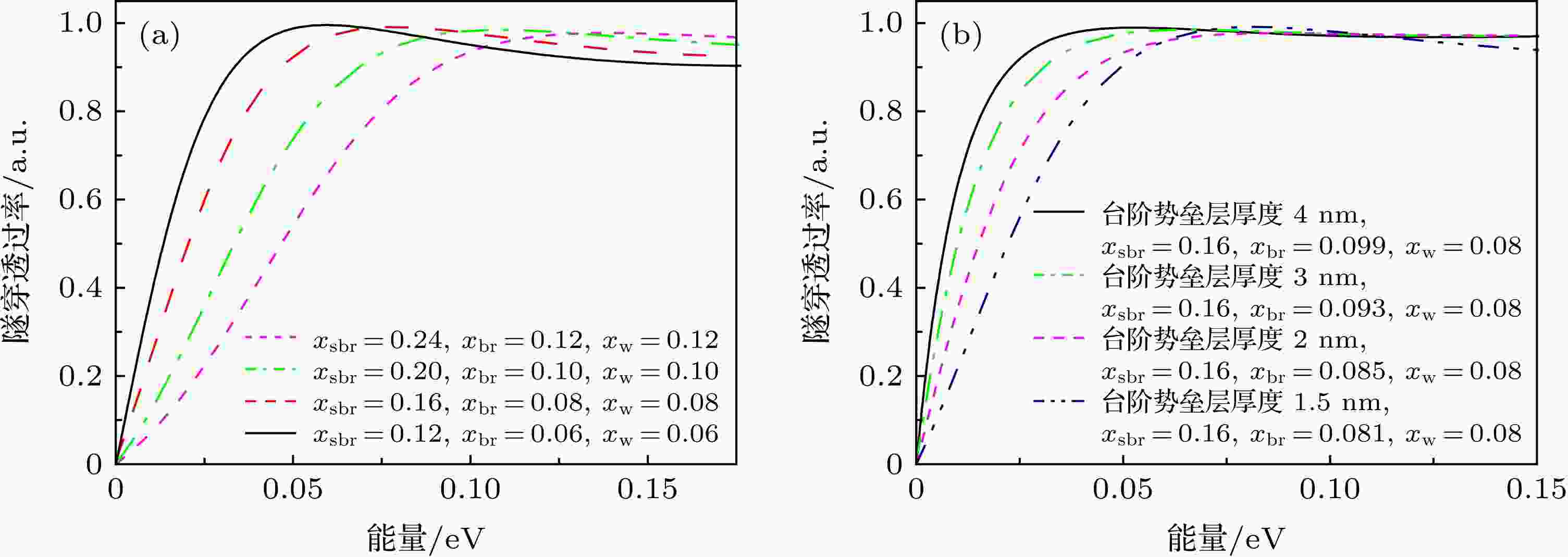 图 7 双台阶结构器件台阶势垒层Al组分(a)和厚度(b)不同时载流子隧穿透过率随载流子能量的变化关系
图 7 双台阶结构器件台阶势垒层Al组分(a)和厚度(b)不同时载流子隧穿透过率随载流子能量的变化关系Figure7. Transmission coefficient as a function of energy for double-step devices: (a) With different Al mole compositions of step barrier layer; (b) with different thicknesses of step barrier layer.
